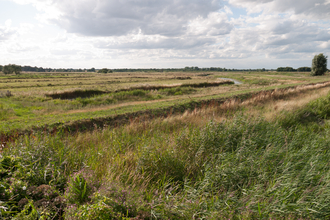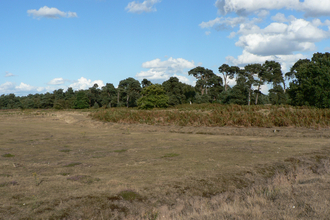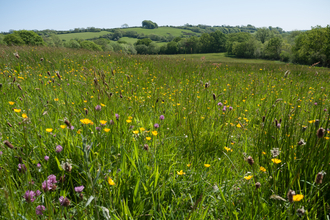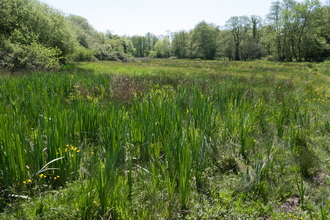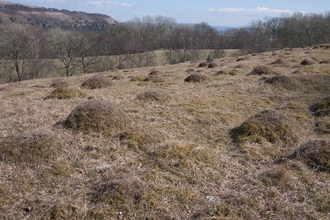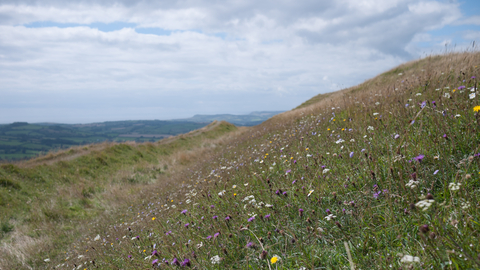
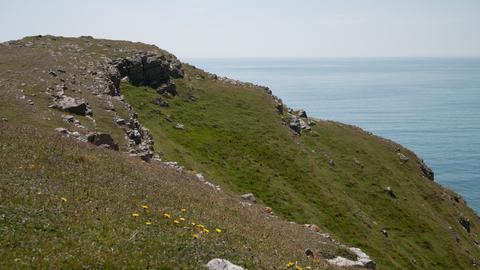
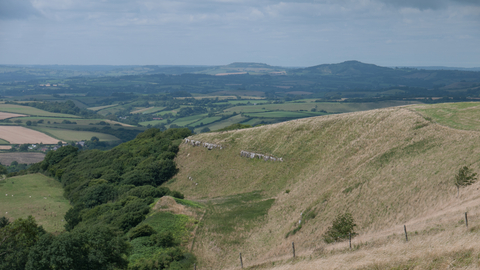


Lowland calcareous grassland
What is it?
Famous for its floristic richness (there can be over 40 species per square metre of turf) and its rare and beautiful butterflies, this habitat is mostly found on the low chalk or hard limestone hills of southern England and along the wilder coastal cliffs and headlands of limestone country in the west of England and in Wales. However, the largest area of chalk grassland in Europe is found on the flat plateau of Salisbury Plain, while in Breckland the dry, winter-cold continental climate has allowed vegetation similar to that found in eastern Europe to develop. Traditionally sheep grazed, the typically short and open turf, well-drained conditions and sunny climate also make it suitable for invertebrates, and there are hundreds of rare species associated with the habitat. Scrub is typically present and includes lime-loving species such as guelder rose, dogwood and burnet rose, in addition to hawthorn and blackthorn, and occasionally juniper. The scrubby grassland margin tends to be less well-grazed, and supports species not found out on the open grassland, such as common calamint and the great green bush-cricket.
Why is it like this?
Lowland calcareous grassland is thought to include some of our most ancient grasslands. Woodland clearance, which started during the Mesolithic Period (11,500 BCE – 4000 BCE), may have occurred first in areas where the woodland was sparse, such as on the thin, well-drained soils found over limestone. Subsequent grazing prevented natural succession back to scrub and woodland and, together with the thin soils, discouraged more vigorous, bulky plants. Together with the warm, dry climate, this created conditions suitable for the characteristic flora and fauna we so appreciate today.
The flora is shaped further by the substrate and location. On the cooler, moister southern and western coastal fringes, species such as carline thistle, yellow-wort, black medick, rock-roses and squills are characteristic on the hard limestones. Farther east, as the climate becomes warmer and drier, quaking grass, meadow oat-grass, wild thyme, dropwort, bird’s-foot-trefoil and salad burnet are common on chalk. In Breckland, a particular type of grassland is found where freeze-thaw cycles after the last glaciation sorted the stony substrate, resulted in a pattern of calcareous grassland and heath. Here the calcareous grassland supports a short sward of wiry sheep’s fescue with rosettes of mouse-ear hawkweed and can include several Brecks rarities.
Distribution in the UK
Chalk grassland is only found in north-west Europe, and a significant proportion of this is in the warm and dry southern counties of England, extending up into the Yorkshire Wolds. Limestone grassland is more widely distributed and in the UK is found on the western and southern coastal strips, the Cotswolds and Mendips, and reaching up in the Derbyshire White Peak, Morecambe Bay and eastern County Durham.
What to look for
Throughout the summer, look for a succession of orchids including early purple, common spotted, pyramidal, fragrant, bee, burnt, greater butterfly, frog and musk orchids and autumn lady’s-tresses. A bit of research helps in finding some of the most special species, including rare orchids, pasque flower, round-headed rampion, early gentian and the Breckland specialities field wormwood, Spanish catchfly, spiked speedwell and maiden pink.
The best places to look for invertebrates are generally on south-facing slopes with a mix of bare ground, short vegetation and longer tussocks, together with plenty of flowering plants. Look for bees, ants, hoverflies, beetles and grasshoppers (including rufous and striped-winged). On sunny days with little wind, clouds of butterflies can still be seen on some of the best sites, including chalkhill, small and Adonis blues. Check also for silver-spotted skipper, Duke of Burgundy, marsh fritillary and Lulworth skipper on sites where these are still known to occur. More common species include dingy skipper, brown argus and, in longer swards, marbled white and meadow brown.
Night-time visits can be rewarding too – look out for glow-worms and for bats feeding on the rich supply of invertebrates.
Conservation
Lowland calcareous grassland was once widespread in the landscape wherever suitable substrate occurred. However, changes to agriculture meant that the more accessible sites began to be ploughed from around 1700 onwards. Once artificial fertilisers became widely used on arable land, downland was no longer valued (as it was previously used as daytime grazing for sheep, which would then fertilise it with their dung). The rate of loss accelerated rapidly in the second half of the 20th century, and now the only areas remaining tend to be on valley sides or escarpments too steep to plough or re-seed, and those reserved for military use.
On the remaining sites, scrub encroachment is a frequent problem (often dating from the virtual disappearance of rabbit grazing after the introduction of myxomatosis in the 1950s). There has been a decline in characteristic species over recent years and an increase in nutrient levels through air pollution - indeed, the ongoing impacts of past habitat loss are of concern. The habitat is best managed through grazing, and usually requires scrub management. Recently, efforts have been made to increase connectivity between fragmented sites to allow species to respond to climate change.


